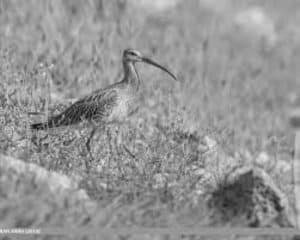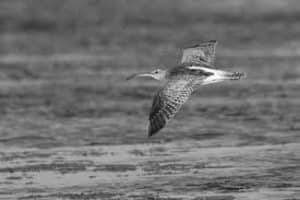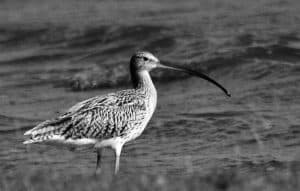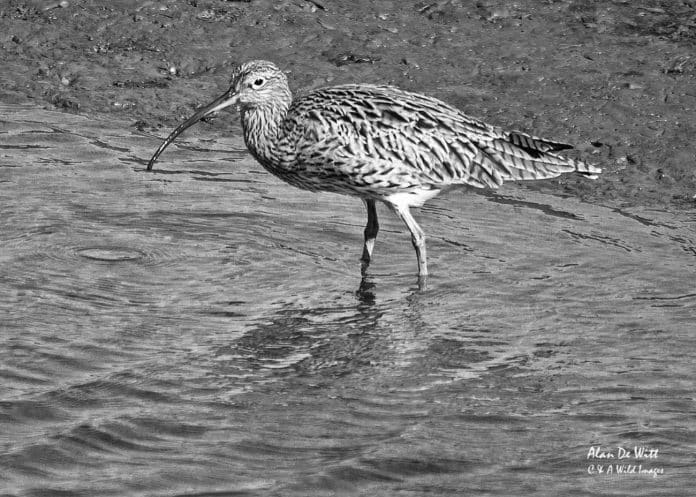Introduction to the Eurasian Curlew
The Eurasian Curlew in Tanzania (Numenius arquata) is a magnificent bird with a distinctive long, curved bill. It is known for its hauntingly beautiful call that adds a musical touch to Tanzania’s coastal areas. This elegant wader is a migratory bird, traveling thousands of kilometers each year to breed and overwinter in different parts of the world. Tanzania’s coastal regions provide an important stopover site for these avian visitors.
Habitat and Distribution of the Eurasian Curlew

The Eurasian Curlew is a species that thrives in diverse habitats, including coastal mudflats, estuaries, and wetlands. These areas offer an abundance of food, such as insects, worms, and small crustaceans, which the curlews feed upon. With their long beaks, they are perfectly adapted to probe deep into the mud and sand in search of their prey.
The distribution of the Eurasian Curlew spans across Europe, Asia, and Africa. In Tanzania, these majestic birds can be found mainly along the country’s eastern coastline, from Tanga in the north to Mtwara in the south. The coastal wetlands and mangrove forests of Tanzania provide an ideal habitat for the curlews during their migration journey.
The Importance of Tanzania’s Coastal Areas for Avian Visitors
Tanzania’s coastal areas are of immense importance for avian visitors, including the Eurasian Curlew. These regions serve as vital stopover sites for migratory birds on their long journeys across continents. The coastal mudflats and wetlands provide abundant food resources and a safe resting place for these weary travelers.
Furthermore, Tanzania’s coastal areas are rich in biodiversity, supporting a wide range of avian species. This makes it a paradise for birdwatchers and nature enthusiasts. The conservation of these habitats is crucial to maintain the delicate balance of ecosystems and ensure the survival of these avian visitors for future generations.
Exploring Tanzania’s Coastal Avian Diversity
Tanzania’s coastal areas boast a remarkable diversity of avian species, making it a haven for birdwatchers. Apart from the Eurasian Curlew, you can spot a wide variety of birds such as flamingos, pelicans, herons, and storks. These coastal regions are also home to endemic species like the Rufous-winged Sunbird and the Pemba Scops Owl. Exploring the avian diversity of Tanzania’s coast is a truly awe-inspiring experience.
To make the most of your avian adventure, it is recommended to visit during the migratory seasons, which are typically from October to March and April to September. During these times, you can witness the arrival and departure of various bird species, including the Eurasian Curlew, as they make their way to and from their breeding grounds.
Discovering the Eurasian Curlew in Tanzania

If you’re eager to spot the Eurasian Curlew in Tanzania, head to the coastal mudflats and estuaries during low tide. These birds are often seen foraging for food in the exposed mud, probing the ground with their long, curved bills. Their distinctive call, a hauntingly beautiful cry, can guide you to their location.
Patience is key when observing the Eurasian Curlew. These birds are known for their skittish nature and will take flight at the slightest disturbance. It is essential to maintain a respectful distance and avoid any sudden movements or loud noises that may startle them. By observing quietly and from a safe distance, you can witness the natural behavior of these elegant birds.
Conservation Efforts and Challenges for the Eurasian Curlew
The conservation of the Eurasian Curlew and its habitat is essential to ensure the survival of this magnificent species. However, these birds face numerous challenges, including habitat loss, pollution, and disturbance from human activities. The destruction of wetlands and coastal areas for urbanization and agriculture poses a significant threat to their survival.
To address these issues, various conservation organizations and local communities are working together to protect the habitats of the Eurasian Curlew and other avian visitors. Efforts include establishing protected areas, raising awareness about the importance of coastal ecosystems, and promoting sustainable practices that minimize the negative impact on these fragile habitats.
The Role of Citizen Science in Monitoring Avian Visitors
Citizen science plays a crucial role in monitoring avian visitors and collecting valuable data about their populations and habitats. By engaging the public in birdwatching and data collection activities, researchers can gather information on bird distribution, migration patterns, and breeding behaviors. This data helps in making informed conservation decisions and implementing effective management strategies.
As a birdwatcher or nature enthusiast, you can contribute to citizen science efforts by participating in bird surveys, reporting your sightings, and sharing your observations with relevant organizations and research projects. Your observations and data can make a significant difference in understanding and conserving the Eurasian Curlew and other avian species in Tanzania.
Tips for Birdwatching and Spotting the Eurasian Curlew in Tanzania

To enhance your birdwatching experience and increase your chances of spotting the Eurasian Curlew in Tanzania, consider the following tips:
- Research and familiarize yourself with the Eurasian Curlew’s appearance, behavior, and habitat preferences.
- Visit during the migratory seasons when the chances of sighting these birds are higher.
- Bring a good pair of binoculars or a spotting scope to observe the birds from a distance.
- Be patient and quiet, allowing the birds to become comfortable in your presence.
- Respect the birds and their habitat by following ethical birdwatching practices and adhering to any local regulations.
By following these tips, you can maximize your birdwatching experience and contribute to the conservation efforts of the Eurasian Curlew and other avian visitors in Tanzania.
Other Avian Species to Look Out for in Tanzania’s Coastal Areas
While the Eurasian Curlew is undoubtedly a highlight of Tanzania’s coastal avian diversity, there are numerous other species to look out for during your visit. Some notable birds include:
- Greater Flamingo (Phoenicopterus roseus): These elegant birds with their vibrant pink plumage can be spotted in large flocks along the coastal mudflats and salt pans.
- African Fish Eagle (Haliaeetus vocifer): With its striking appearance and piercing call, this majestic raptor is a symbol of Tanzania’s wildlife.
- Malachite Kingfisher (Corythornis cristatus): This small, colorful kingfisher can be found perched on branches near water bodies, where it dives to catch fish.
Remember to keep your eyes and ears open during your birdwatching excursions, as Tanzania’s coastal areas are teeming with avian treasures waiting to be discovered.
Conclusion: Preserving the Eurasian Curlew’s Habitat in Tanzania
Tanzania’s coastal areas are not only a paradise for avian visitors but also crucial habitats that must be preserved. The Eurasian Curlew, with its enchanting presence and haunting call, is just one of many remarkable species that rely on these coastal regions during their migration.
By raising awareness about the importance of conservation and supporting initiatives that protect the habitats of avian visitors, we can ensure the survival of these magnificent birds for generations to come. Let us cherish and preserve Tanzania’s coastal avian diversity, including the Eurasian Curlew, for the enjoyment and wonderment of future birdwatchers and nature enthusiasts.


































